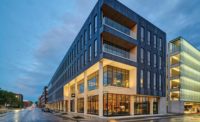Installing a perimeter diaphragm wall to waterproof a shared deep basement of three 50-story office towers has been, so far, the biggest challenge for crews working on part of a nearly $6.1-billion waterfront redevelopment in Sydney. Laying the foundation for the ambitious Barangaroo South project, sited on 7.5 hectares of public land, is part of a scheme to create a replicable model for cradle-to-grave, grand-scale carbon-neutral development, starting from the moment construction begins to the end of the useful life of the buildings.
Barangaroo South, on the site of a former container wharf, aims to be carbon-neutral in operation, including energy, waste and commuter carbon emissions, says Anita Mitchell, general manager of sustainability for the local Lend Lease (LL), which acquired the Barangaroo South development rights from the New South Wales’ (NSW) Barangaroo Delivery Authority in late 2009.
The broader purpose is “to provide a replicable model for the rest of the construction sector to reduce the life-cycle impact of buildings,” Mitchell says.
The goal is to apply sustainable construction principles to every niche of the project, squeezing as much embodied carbon out of the development as possible. To ensure the project meets sustainability commitments, the LL team will publish an annual sustainability report and create a biennial review of benchmarks.
Barangaroo South, on the western edge of Sydney Harbour, is a multi-use, high-rise village in the 22-acre NSW-owned redevelopment tract, called Barangaroo. The 5.5-hectare Barangaroo Central and the 6-hectare Headland Park are the other two sections of Barangaroo.
The Barangaroo redevelopment is a project of the NSW government, which created the Barangaroo Delivery Authority to manage the project. NSW retains land ownership.
The Barangaroo project, Sydney’s biggest since the 2000 Olympics, is expected to be substantially complete by 2022. Currently, Skidmore, Owings & Merrill is developing a master plan for the Barangaroo South district. The park is under construction.
LL is responsible for designing, financing, constructing and leasing all the Barangaroo South buildings. LL is also one of the investors in the first two office towers, with a 25% equity interest. The estimated cost of the office towers and the development’s shared two-level basement is $3 billion, according to LL.
Barangaroo South construction began in 2011. In addition to the office towers, which will contain a total of 300,000 sq m of space, there will be three residential towers, containing 800 to 1,000 units, and a 350-room hotel tower. The other components, including 80 to 100 retail outlets and 10,000 sq m of community facilities, will be in low-rise buildings.
Long before a shovel hit the ground, the LL team developed a sustainable design and construction strategy. “For the embodied carbon of the precinct, we have set ourselves a reduction target of 20% compared to standard construction practice,” says Mitchell.






Post a comment to this article
Report Abusive Comment